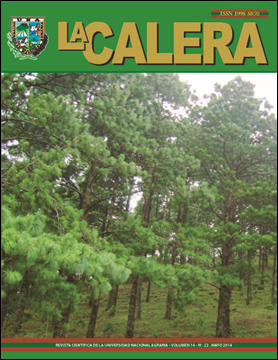Status of tree vegetation and floristic structure of the riparian strips in the watershed Las Chichiguas, La Concordia-Jinotega, Nicaragua, 2011
DOI:
https://doi.org/10.5377/calera.v14i22.2651Abstract
This study was conducted in the micro-watershed Las Chichiguas, municipality of La Concordia, Jinotega Department, as part of the research Scientific Experimental National Agrarian University as part of the International Project UNA / CARE / MARENA-PIMCHAS. This research has as its main objective assessment of the state of the treeline and floristic structure in which is the area riparia watershed the Chichiguas, to achieve this goal the methodological and environmental physical diagnosis at the site level, high, medium and low, on a per experimental riparian forest inventory. Variables were available that make the analysis of biodiversity indices and estimated population estimates by the number of individuals, identifying the most critical or degraded, diagnosing their causes and possible solutions. The research was conducted in three stages: the first involves the recognition of the study area, the second systematic forest inventory and the third riparian vegetative diagnosis, including abundance, found 194.59 ind / ha of the 22 species, 3 species are the most representative, obtaining 13.64% of the total. These species are: Quina (Croton draco), calf Guácimo (Pithecellobiun) and Cuajiniquil species (Inga vera). These 3 species had a frequency of 43.48% of total species sampled in 16 plots and a dominance of certain species from the basal area of vegetation in the watershed of 65.41 square meters, the total value is represented in species with larger dominance such as Cuajiniquil (Inga vera = 18.24%), calf Guácimo (Pithecellobium = 6.50%) and Quina (Croton draco = 1.33%) of total species. We calculated total density of species over 10 cm DBH and Biodiversity indices according to Shannon Wiener and Simpson. Based on site conditions (without impairment, moderately impaired and highly impaired) the results indicated that in the middle of the riparian area of the watershed is moderately impaired, highly damaged the lower and upper without deterioration. This study concluded that major factors in deterioration of greater or lesser degree of the watershed is presented in the vegetative or coverage factor, being the principal cause of land use change from forest to pasture and crop areas, causing a factor of potential erosion and sedimentation of soils.
La Calera, Vol.14 No.22, Mayo 2014, pp.13-20
Downloads
1028

